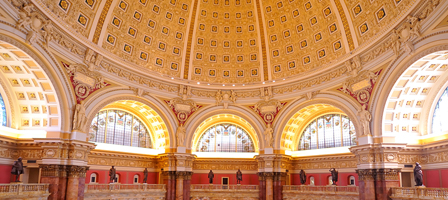Library of Congress
From Wikipedia, the free encyclopedia
Pictured: Interior of the dome, Main Reading Room, the Thomas Jefferson Building. Take a virtual tour at the Library of Congress website
The Library of Congress is the research library of the United States Congress, de facto national library of the United States, and the oldest federal cultural institution in the United States. Located in three buildings in Washington, D.C., it is the largest library in the world by shelf space and number of books. The head of the Library is the Librarian of Congress, currently James H. Billington.
The Library of Congress was built by Congress in 1800, and was housed in the United States Capitol for most of the 19th century. After much of the original collection had been destroyed during the War of 1812, Thomas Jefferson sold 6,487 books, his entire personal collection, to the library in 1815.[2][3] After a period of decline during the mid-19th century the Library of Congress began to grow rapidly in both size and importance after the American Civil War, culminating in the construction of a separate library building and the transference of all copyright deposit holdings to the Library. During the rapid expansion of the 20th century the Library of Congress assumed a preeminent public role, becoming a “library of last resort” and expanding its mission for the benefit of scholars and the American people.
The Library’s primary mission is researching inquiries made by members of Congress through the Congressional Research Service. Although it is open to the public, only Members of Congress, Supreme Court justices and other high-ranking government officials may check out books. As the de facto national library, the Library of Congress promotes literacy and American literature through projects such as the American Folklife Center, American Memory, Center for the Book and Poet Laureate.
Holdings
The collections of the Library of Congress include more than 32 million cataloged books and other print materials in 470 languages; more than 61 million manuscripts; the largest rare book collection in North America, including the rough draft of the Declaration of Independence, a Gutenberg Bible (one of only four perfect vellum copies known to exist);[10] over 1 million US government publications; 1 million issues of world newspapers spanning the past three centuries; 33,000 bound newspaper volumes; 500,000 microfilm reels; over 6,000 comic book[11] titles; films; 5.3 million maps; 6 million works of sheet music; 3 million sound recordings; more than 14.7 million prints and photographic images including fine and popular art pieces and architectural drawings;[12] the Betts Stradivarius; and the Cassavetti Stradivarius.
The Library developed a system of book classification called Library of Congress Classification (LCC), which is used by most US research and university libraries.
The Library serves as a legal repository for copyright protection and copyright registration, and as the base for the United States Copyright Office. Regardless of whether they register their copyright, all publishers are required to submit two complete copies of their published works to the Library if requested—this requirement is known as mandatory deposit.[13] Parties wishing not to publish, need only submit one copy of their work. Nearly 22,000 new items published in the U.S. arrive every business day at the Library. Contrary to popular belief, however, the Library does not retain all of these works in its permanent collection, although it does add an average of 10,000 items per day. Rejected items are used in trades with other libraries around the world, distributed to federal agencies, or donated to schools, communities, and other organizations within the United States.[14] As is true of many similar libraries, the Library of Congress retains copies of every publication in the English language that is deemed significant.
The Library of Congress states that its collection fills about 838 miles (1,349 km) of bookshelves,[15] while the British Library reports about 625 kilometres (388 mi) of shelves.[16] The Library of Congress holds about 147 million items with 33 million books against approximately 150 million items with 25 million books for the British Library.[15][16]
The Library makes millions of digital objects, comprising tens of petabytes, available at its American Memory site. American Memory is a source for public domain image resources, as well as audio, video, and archived Web content. Nearly all of the lists of holdings, the catalogs of the library, can be consulted directly on its web site. Librarians all over the world consult these catalogs, through the Web or through other media better suited to their needs, when they need to catalog for their collection a book published in the United States. They use the Library of Congress Control Number to make sure of the exact identity of the book.
The Library of Congress also provides an online archive of the proceedings of the U.S. Congress at THOMAS, including bill text, Congressional Record text, bill summary and status, the Congressional Record Index, and the United States Constitution.
The Library also administers the National Library Service for the Blind and Physically Handicapped, a talking and braille library program provided to more than 766,000 Americans.
Text is available under the Creative Commons Attribution-ShareAlike License; additional terms may apply. See Terms of use for details.
Wikipedia® is a registered trademark of the Wikimedia Foundation, Inc., a non-profit organization.
Learn more at Wikipedia/Library of Congress, Wikipedia/Thomas Jefferson Building, or visit Library of Congress website
Copyright © 2011 • KLM, Inc. • All Rights Reserved






